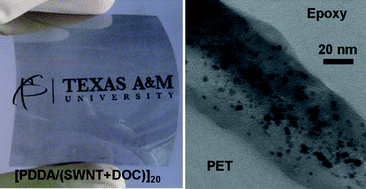Heating and acid doping thin film carbon nanotube assemblies for high transparency and low sheet resistance†
Abstract
Transparent electrodes made from metal

* Corresponding authors
a
Department of Mechanical Engineering, Texas A&M University, College Station, TX, USA
E-mail:
jgrunlan@tamu.edu
Fax: +1 979 862 3989
Tel: +1 979 845 3027
Transparent electrodes made from metal

 Please wait while we load your content...
Something went wrong. Try again?
Please wait while we load your content...
Something went wrong. Try again?
Y. T. Park, A. Y. Ham and J. C. Grunlan, J. Mater. Chem., 2011, 21, 363 DOI: 10.1039/C0JM02524K
To request permission to reproduce material from this article, please go to the Copyright Clearance Center request page.
If you are an author contributing to an RSC publication, you do not need to request permission provided correct acknowledgement is given.
If you are the author of this article, you do not need to request permission to reproduce figures and diagrams provided correct acknowledgement is given. If you want to reproduce the whole article in a third-party publication (excluding your thesis/dissertation for which permission is not required) please go to the Copyright Clearance Center request page.
Read more about how to correctly acknowledge RSC content.
 Fetching data from CrossRef.
Fetching data from CrossRef.
This may take some time to load.
Loading related content
